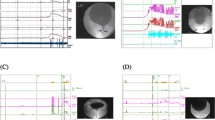Abstract
The objective of this study was to investigate the differential diagnostic capacity of the frequency/volume chart. Thus the readings of a 48-hour frequency/volume chart were compared to the urodynamic findings in 62 motor urgency incontinent women and 80 genuine stress incontinent women. Applying logistic regression to the parameters of the frequency/volume chart, with the urodynamic diagnosis as the gold standard, the effectiveness of different parameters and parameter combinations to differentiate motor urgency incontinence from genuine stress incontinence could be estimated. The best differentiating single parameters of the chart were the frequency of micturition and the mean voided volume. A combination of two parameters improved differentiation, with the frequency of micturition in combination with some measure of variability, e.g. the range of voided volumes, being the best. From these results, plots indicating the probability of a diagnosis could be calculated. It is concluded that the frequency/volume chart has differential diagnostic properties. A new feature of the chart, the variability of voided volumes, is introduced and shown to improve the differentiating capacity.
Similar content being viewed by others
References
Fall M, Frankenberg S, Frisèn M, Larsson B, Petrén M 456.000 svenskar kan ha urininkontinens. Endast var fjärde söker hjälp för besvären. Läkartidningen 1985;82:2054–2056
Feneley RCL, Shepherd AM, Powell PH, Blannin J. Urinary incontinence: prevalence and needs. Br J Urol 1979;51:493–496
Thomas TM, Plymat KR, Blannin J, Meade TW. Prevalence of urinary incontinence. Br Med J 1980;281:1243–1245
Urinary incontinence in adults. National Institutes of Health Consensus Development Conference Statement 1988;7:5
Urininkontinens hos vuxna. Medicinska Forskningsrådet och Spri 1986; 135
Gaudenz R. Der Inkontinenz-Fragebogen mit dem neuen Urge-Score und Stress Score. Geburtsch Fraunenheilk 1979;3:784–792
Kujansuu E, Kauppila A. Scored urological history and urethrocystometry in the differential diagnosis of female urinary incontinence. Ann Chir Gynecol 1982;71:197–202
Sand PK, Hill RC, Ostergard DR. Incontinence history as a predictor of detrusor stability. Obstet Gynecol 1988;71:257–259
Versi E, Cardozo L, Anand D, Cooper D. Symptoms analysis for the diagnosis of genuine stress incontinence. Br J Obstet Gynecol 1991;98:815–819
Larsson G, Abrams P, Victor A. The frequency/volume chart in detrusor instability. Neuroural Urodyn 1991;10:533–543
Larsson G, Victor A. The frequency/volume chart in genuine stress incontinent women. Neurourol Urodyn 1992;11:23–31
Abrams P, Blaivas JG, Stanton SL, Andersen JT. The standardization of terminology of lower urinary tract function. Int Urolgy Med J 1990;1:45–58
Kotz GG, Edwards S. Logistic regression. In: Kotz S, Johnson NL, Read CB, eds. Encylopedia of statistical sciences. Wiley Interscience 1984; New York.
Author information
Authors and Affiliations
Rights and permissions
About this article
Cite this article
Larsson, G., Blixt, C., Janson, G. et al. The frequency/volume chart as a differential diagnostic tool in female urinary incontinence. Int Urogynecol J 5, 273–277 (1994). https://doi.org/10.1007/BF00376239
Issue Date:
DOI: https://doi.org/10.1007/BF00376239




